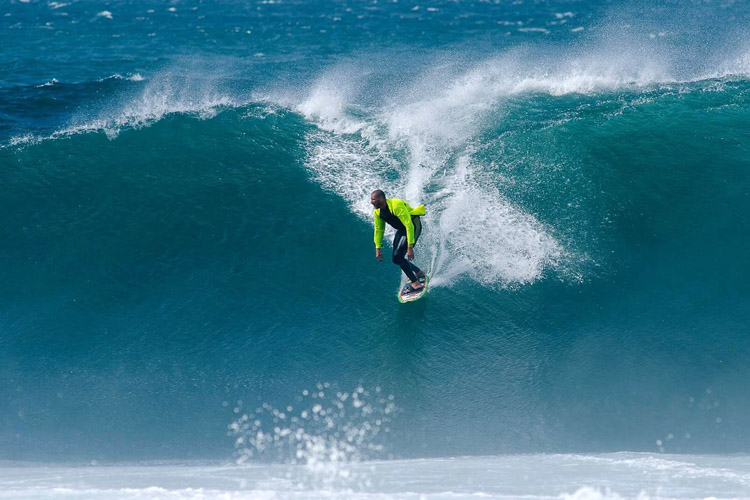David Langer says that on January 10, 2014, "a single moment on a single wave changed his life forever." That moment was a beautiful barrel, and the wave was Jaws/Peahi.
Today, the big wave surfer lives and breathes Nazaré. The Californian fell in love with Praia do Norte, and the Portuguese fishing town adopted him as a son.
Jennifer Schmeer was able to catch up with him in Nazaré. David had just been bestowed with the indoctrination in the Surfer Wall, inside the town's ancient lighthouse.
Hi, David. How are you?
Thank you for having me! Welcome to beautiful Nazaré! I am sold completely 100 percent on this place - Portugal. I moved here from Maui and California originally.
I grew up in Fullerton, California, surfing Newport and Huntington Beach and stuff, then went to Jalama State Park and San Diego for bigger waves.
From there, I went to Mexico and Hawaii, then to Tahiti and some other places, but mostly I moved to Jaws.
I surfed a lot there, then came here after some time in Puerto Escondido. So, here I am in Nazaré.
Where are your parents from, and what is your ethnic background?
My dad is from Vienna, in Austria. He ran from there when he was seven.
He was born in 1931, so in 1938 he had to run from the Nazis; my grandfather got caught, put in a camp, and then escaped to Chicago, where he sent my father, grandmother, and my father's sister.
My grandfather was a bit messed up from being in a camp, and my dad had to take care of him.
So, my dad had this upbringing where he became a father at the age of seven or eight. And he moved to California when he was 38 or something, right around the time I was born in 1970.
My ethnic background is Jewish, and my mom is from Florida. She is Jewish as well.
(Someone walks into the room) My partner, Alemao, just got here. He's a huge part of what I do. Without partners in tow surfing, you would be nothing.
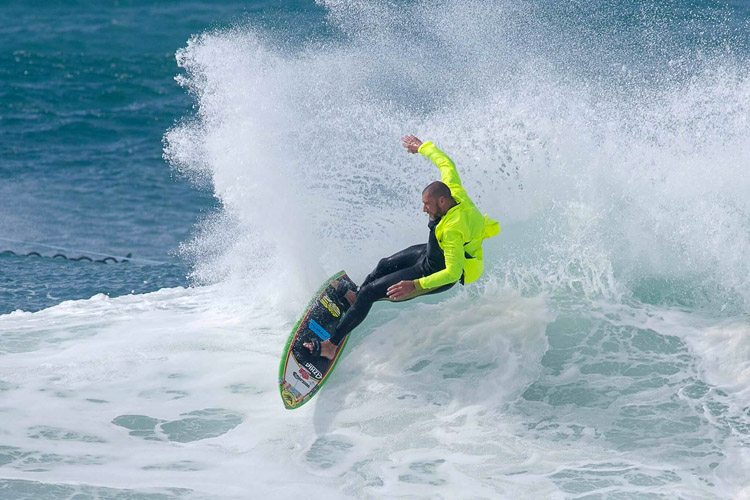
What did your parents do for jobs while you were growing up?
My dad was a writer. He wrote the annual reports for Mutual Fund Investment Company.
Try explaining that one when you're a little kid. Not an easy one. He was not a firefighter. It was not just one or two words.
That's what he did: he wrote reports for Mutual Fund Investment Company.
He was actually asked to be an Ambassador to Austria by both Presidents Regan and Bush because he was so good at writing about mutual funds.
He was really good at that. My mom was a realtor in real estate.
What did you want to be as a young boy?
I wanted to be a lawyer. I thought.
What was life like in Maui?
Life in Maui was beautiful and confining all at once. I think it is one of the most beautiful places in the world.
So do 99 percent of the people that come there that won't live there. Only a small percentage of people who come to Maui would actually live there.
It's an interesting place to be, live, and call home. As long as you can move around and get off the island frequently, it's probably the best place to live in the world.
But Portugal is better, as there are no drug wars here. Waves are bigger. Culture is deeper. The food is better.
No GMOs, no pesticides. The list goes on. The people here are incredible. So, Portugal has me.
The first place ever surfed?
It was Waikiki. I was pushed into a wave by a local guy and got a picture standing there with my hands up, making peace signs.
That way, I could show everybody I could surf. I was coming from bodyboarding and I couldn't get any credit for surfing and, yes, I wanted that.
Who taught you how to surf?
That Hawaiian guy. That was it after that.
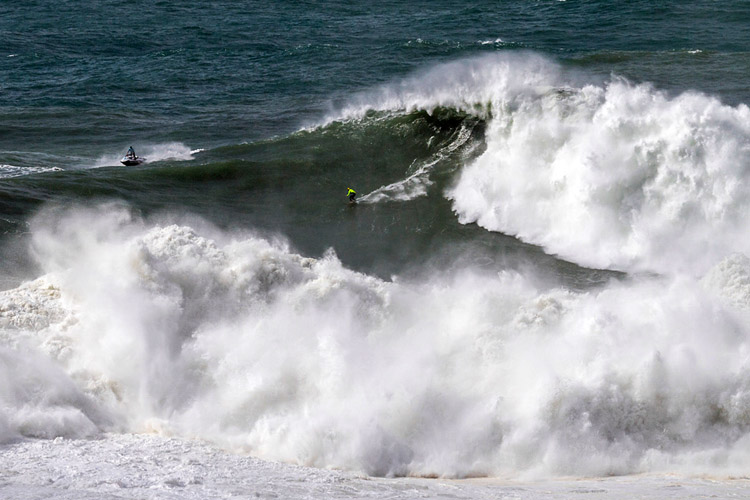
Where did you get your first taste for big wave riding?
A big wave to, when I was little, was waist high. The first big wave was at Jalama State Park.
I went there, and it was 20 feet on the face, and it looked like little kids were riding it. I couldn't fathom it.
Someone could be that small, and the wave could be that big. And then they came to the shoulder, and they had mustaches, you know, six feet tall.
It blew my mind. So, yes, Jalama was the first place I ever surfed big waves.
Best advice ever received?
"Keep surfing," from Dane Kealoha, although my dad gave me a lot of good advice. Yes, anyway, surfing is really important to me. Saved my life in many ways.
Who are your sponsors?
Opkix is a really important sponsor: they are in competition with GoPro, and they may even blow GoPro away. It's a little element that feeds into your cell phone.
Sector 9 skateboards: I've been with them for over a decade, and it's really important to me.
Matuse wetsuits: I've just hooked up with them recently, and they're beautiful people.
Credito Agricola: a bank here. They've just funded this documentary that we are doing. It's amazing. I'm super stoked for their support!
Lacrau Surfboards and Oliveira Alves Cork Company: that's where we got the blanks from.
Shape Land: they put the blanks together and put the glass on the boards here in Portugal. The guys are just incredible.
Kind Snacks: an unreal sponsor.
I am sure the list goes on. I've had a lot of sponsors in the past that have come and gone, like Sanuk. I was with them for decades. Hydro Fins, Mike Jones, etc.
Impressive. Favorite place to surf?
Nazaré.
Biggest wave ever ridden?
Nazaré.
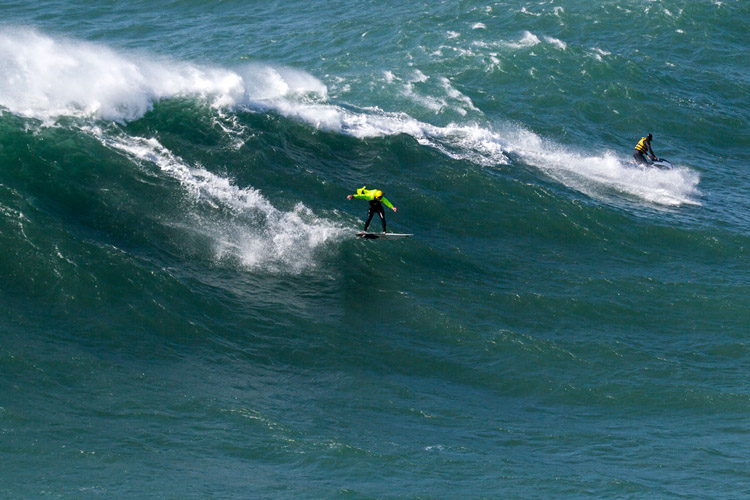
What boards do you have with you now in Nazaré?
A cork surfboard made by Oliveira Alves, shaped by Shape Land, and funded by Crédito Agricola.
How big is it there right now?
It's between 10 and 12 feet. Shore break, small, bowling, and spitting. Relatively flat.
What have your sessions been like so far?
Random. A couple of times. Two times a week. It varies every time. A lot like the wedge in Newport or Sunset, Waimea, Puerto, and Jaws.
How long are you in the water for each session with waves like that?
It varies. From a couple of hours to all day. You never know.
How do you prepare to surf waves like Nazaré?
Mentally, a lot. Skateboarding, biking - just keeping your emotional content straight. Stretching.
Like the Bruce Lee philosophy. Emotional content was really important to him, and I believe in that.
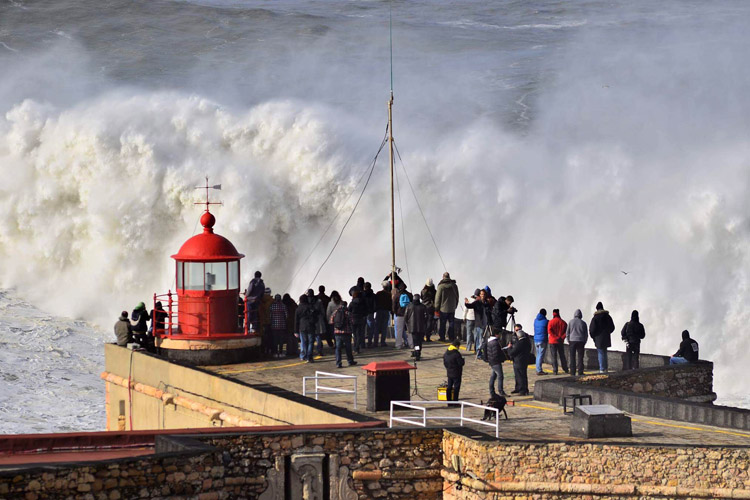
Are you able to sleep the night before tackling waves like Nazaré?
It's tough. Definitely tough.
When you sleep, what are your dreams like?
In general, sometimes I remember my dreams, sometimes I don't. I can't even remember the last one I had. Lately, I haven't been remembering my dreams.
What is your diet like?
I was a vegetarian for ten years. I watched my diet pretty well. I eat to feel well. Sometimes, I also slip, and it doesn't make me feel well.
Here in Portugal, it's difficult to eat a good breakfast. It's just coffee and bread - not the best things in the morning.
I like juices and stuff like that a lot. Fresh fish, veggies, and soups here are incredible. It's the best food in the world.
Any bad habits we should know about?
Sure. Staying up too late, not eating right, burning too much, not training enough. Whatever, you know. I try to strike a balance.
Tell me about the Surfer Wall of Fame in Nazaré.
The Surfer Wall of Fame is the kind of thing you could only dream of.
A fort built in 1577 and preserved for what is now a museum, containing the story of the canyon that helps to form the unique wave here.
Included now are the boards of the surfers who have dedicated their time and efforts to rising to the challenge of riding these waves.
What does it mean to you?
It is difficult to describe what it means to me to see this fort with a single board in it at first, much less with a museum full now.
Upon learning of the wave and the town, and most importantly, the people who support us so thoroughly here in Nazaré, it was sort of surreal first witnessing it.
A fort that could be closed to the public and that was closed to the public for over 400 years... now holding a surfboard with a Mercedes Benz logo on it made me proud of the sport and the country hosting it.
It made me proud of Garrett and Nicole, along with all the people who welcomed them and worked so hard to show the world what we do. I'm honored, really.
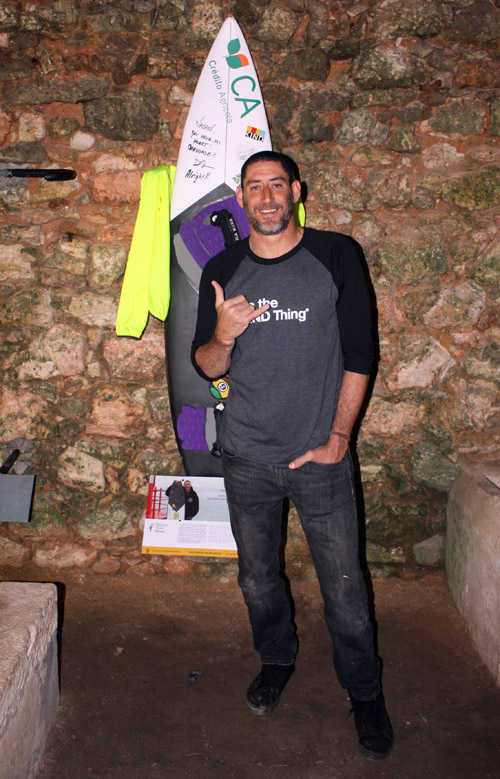
How do you pick which board goes in the lighthouse?
At first, I thought that a board I would use out there in the water beyond those walls was one I should keep ready to do so, not hang in the lighthouse.
Yet, after some thought and the offer from the mayor to grab it if needed, just as long as we return it after we surf, I decided to put my best board there.
It is ready to go, just in case the new boards don't handle properly or are in the shop getting repaired.
Did you shed any tears when they gave you this honor?
Actually, I did shed a tear or two as they gave me this honor.
More specifically, I remembered the time and dedication to this wave spent away from my kids and the sacrifice I truly feel is worth that time away.
I am the first international surfer to have ever loved Nazaré so much that I moved there.
The cost was and is enormous, especially with kids involved, yet it is worth it 100 percent.
How did you celebrate that night?
I did celebrate, yes. There was a homemade chocolate cake with candles spelling "Alright" waiting at the apartment for me.
Thank you, Cecilia!
Missing my girls and plotting how to take the next step forward, preparing for the next day of surf either by way of equipment, physical, mental, or even emotional content consumed me shortly after that.
It is an Olympic training center essentially here in Nazaré. Love it!
Words by Jennifer Schmeer
